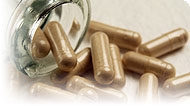Search Healthnotes
Amino Acids Overview

How to Use It
Nutrition experts recommend that protein, as a source of amino acids, account for 10–12% of the calories in a balanced diet. However, requirements for protein are affected by age, weight, state of health, and other factors. On average, a normal adult requires approximately 0.36 grams of protein per pound of body weight. Using this formula, a 140-pound person would need 50 grams (or less than 2 ounces) of protein per day. An appropriate range of protein intake for healthy adults may be as low as 45–65 grams daily. Some athletes have higher amino acid requirements.1 Most American adults eat about 100 grams of protein per day, or about twice what their bodies need and at least as much as any athlete requires.
Supplements of individual amino acids are recommended by doctors for specific purposes, such as lysine for herpes or phenylalanine for pain.
Where to Find It
Foods of animal origin, such as meat and poultry, fish, eggs, and dairy products, are the richest dietary sources of the essential amino acids. Plant sources of protein are often deficient in one or more essential amino acids. However, these deficiencies can be overcome by consuming a wide variety of plant foods. For example, grains are low in lysine, whereas beans provide an excess of lysine. It was previously believed that, in order for vegetarians to obtain adequate amounts of protein, all of the essential amino acids had to be “balanced” at each meal. For example, a grain and a bean had to be consumed at the same meal. However, more recent research has indicated that, while consuming a proper mix of amino acids is important, it is not necessary to consume them all at the same meal.2
Possible Deficiencies
The vast majority of Americans eats more than enough protein and also more than enough of each essential amino acid for normal purposes. Dieters, some strict vegetarian body builders, and anyone consuming an inadequate number of calories may not be consuming adequate amounts of amino acids. In these cases, the body will break down the protein in muscle tissue and use those amino acids to meet the needs of more important organs or will simply not build more muscle mass despite increasing exercise.
Copyright © 2026 TraceGains, Inc. All rights reserved.
Learn more about TraceGains, the company.
The information presented by TraceGains is for informational purposes only. It is based on scientific studies (human, animal, or in vitro), clinical experience, or traditional usage as cited in each article. The results reported may not necessarily occur in all individuals. Self-treatment is not recommended for life-threatening conditions that require medical treatment under a doctor's care. For many of the conditions discussed, treatment with prescription or over the counter medication is also available. Consult your doctor, practitioner, and/or pharmacist for any health problem and before using any supplements or before making any changes in prescribed medications. Information expires December 2026.











